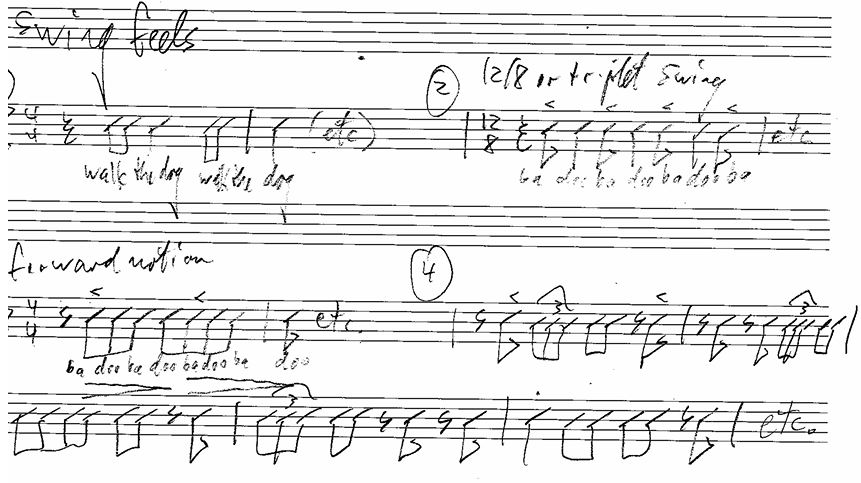How African 6/8 is connected to 4/4 swing
incorporating Afro-Cuban 6/8 clave into 4/4 swing
tips from Charles Harrison
Charles Harrison
—-
metheny quote
counting, timing, groove, swing etc. are all very closely related; focus entirely on rhythm and don’t play things that make your rhythm suffer
rhtyhmic accuracy is not metronomic; groove / feel / swing is more interested in how subdivisions are divided – it’s how well you’re locked in with others within the style – play along with recordings and align it with recording, even just by listening it and not playing along; extract “groove template” from recordings
—-
tuplets & polyrhtyms
tuplet is a ratio like 3:2, 6:4, 5:4,
can divide a beat into any number of subdivisions, like 1 a pot a mus 2 a pot a mus (for 5s)
take first number (ex: 3:2) and that’s the counting row you use; look at how many you’ll have to count it over which tells you the starting point for each cycle
ex: 5:4
the five tells us to divide each beat into 5 subdivisions but count them in groups of 4
ex: 7:3
seven subdivsions per beat grouped in 3s over 3 beats
1. first number tells us subvisions per beat
2. how many whole beats the tuplet will cross
3. group the subdivision accordingly
—-
there is a spectrum of amount of swing and also amount of swing from precision like martino to looseness like scofield
1. upbeat accent – | 1 2 3 4 | 1 2 3 4 | where 4 of bar 2 gets accent, or even tie it over to the next 1, Hal Galper (in “The Zone”) said that’s the key to syncopation
2. upbeat accent | 1 & 2 & 3 & 4 & | where & of 4 is accented
3. alternate between accenting the and of 4 and the 4 in 2 back to back bars
4. apply swing to this by playing these patterns along with your favorite player’s recordings, adjusting amount of swing accordingly, and even play scale in key but continue the accents
—-
forward motion by Hal Galper
1. think in half time
2. line always moves towards beats 1 & 3, so accent & of 1 and continue getting quieter in 8ths until beat 3, then accent the and of 3 and do the same until beat 1
i.e. BA doo b d BA doo b d
anything you play, force that phrasing over it for a couple of months
then on top of that you can add bebop lines; this was life-changing
—-
16th notes and how to swing them
listen to Brecker, Scofield, Metheny & look at the way they group them together, i.e. where the accenting & phrasing
Longo’s rhythm pile is about how they are grouped
1. groups of 3 16ths
2. groups of 5
3. pair 2 groups ex: 3 + 5 resolves to 1; even want to keep it unresolved, pair odd and even groups like 3, 4, 3, 2, 5, 4, 3, 2
—-
what a metronome is actually for
get robotic device to feel like it’s grooving
1. four on the floor and play explore different subdivisions of each beat
2. click on 1 and 3 only
3. click on 2 and 4 only
4. click on 4 only
5. 1 click per 2 bars (on any beat)
6. 1 click per 4 bars (on any beat)
7. different pitches for triplet groove as in:
|—2–a3-a4-a|1-a2-a—4-a|
—-
1. emulate conversational phrases, i.e. rhythm first
2. forward motion (Hal Galper) – something has a feeling of forward motion or not, like 16th notes accenting each downbeat doesn’t have forward motion, but starting on the e of 1 does, for example, there’s a sense of propulsion there
3. ontological (Mike Longo) – by tapping into the Source, we allow that source to guide you; make a clear positive statement and then 2nd phrase is a reiteration of that (either a repetition, or similar but not identical) and then the direction unravels from there; start with something simple, repeat it (ish) and let the rest unfold
—-
(see photo below)
—-
Dizzy swing & Long rhythm pile
(see Dennis’ summary of Mike Longo’s Rhythmic Nature of Jazz)



